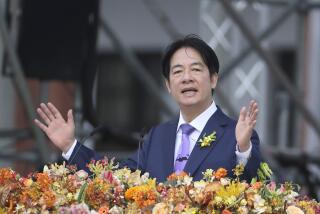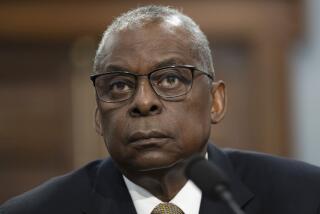Pentagon sends two warships through Taiwan Strait, further straining relations with Beijing
- Share via
Reporting from Washington — Two U.S. warships sailed through the Taiwan Strait on Monday, a show of military support for the self-ruled island of Taiwan by the Trump administration that is sure to worsen already-tense relations between Washington and Beijing.
The Antietam, a guided-missile cruiser, and the Curtis Wilbur, a guided-missile destroyer, sailed from the south to the north through the strait and were shadowed by multiple Chinese navy vessels at a safe distance, according to a U.S. official.
The 110-mile-wide waterway separating Taiwan from the mainland is an international passage, but it is a potential flashpoint if China ever sought to use force to take control of Taiwan, which Beijing considers a breakaway province.
“The ships’ transit though the Taiwan Strait demonstrates the U.S. commitment to a free and open Indo-Pacific,” said Lt. Rachel McMarr, a spokeswoman for the U.S. Pacific Fleet. “The U.S. Navy will continue to fly, sail and operate anywhere international law allows.”
Col. Rob Manning, a Pentagon spokesman, told reporters that before the passage through the strait, the U.S. “maintained coordination and contact with the appropriate nations, authorities and parties” and that it was “certainly not the intention to raise tensions or any kind of escalation” across the Taiwan Strait.
The Trump administration has been more publicly supportive of the U.S.-Taiwan relationship than any administration in recent decades. In addition to Monday’s operation, the Pentagon sent two warships through the strait in July. In past years, the U.S. usually sailed in the strait only once a year.
Abraham Denmark, who was the Pentagon’s deputy assistant secretary for East Asia during the Obama administration, said past U.S. transits were conducted quietly, to avoid provoking Beijing into making threatening moves against Taiwan.
“To me the ultimate question is, ‘Does this help Taiwan?’” Denmark said. “I think it’s good to demonstrate continued U.S. commitment to Taiwan, but the question is, ‘Does it need to be conducted so publicly?’”
The move is part of a pattern of mixed signals from the administration. It comes just four days after Defense Secretary James N. Mattis met with Chinese Defense Minister Wei Fenghe in Singapore in what Pentagon officials said was an effort to reestablish contacts between U.S. and Chinese military leaders after months of tit-for-tat quarrels.
That conciliatory Singapore meeting followed a slashing speech by Vice President Mike Pence this month outlining a more confrontational U.S. approach toward Beijing. On Sept. 30, a Chinese navy vessel nearly collided with a U.S. warship that was sailing in the South China Sea, in a challenge to Beijing’s disputed maritime claims there.
Beijing had no immediate reaction to the U.S. transit of the Taiwan Strait. China claims Taiwan as its own and has never renounced the use of force to bring the island under its control.
The issue of U.S. support for Taiwan came up during Mattis’ talks with Wei, according to Randall Schriver, the assistant secretary for Asia at the Pentagon. Mattis reassured Wei that the United States had not altered the U.S. policy, Schriver said.
That policy, established when Washington and Beijing normalized relations in 1979, acknowledges that China claims Taiwan as part of its territory. But that policy also warns Beijing against trying to reclaim the island by force.
The U.S. does not have formal diplomatic ties with Taiwan and has no formal commitment to come to the island’s defense if attacked. But under the 1979 Taiwan Relations Act, the U.S. promised to maintain the military capacity to come to Taiwan’s aid, a policy meant to leave Beijing uncertain about how the U.S. would respond in case of a Chinese attack on the island.
By sending warships through the waterway so soon after the Mattis-Wei meeting, the Pentagon appeared to be sending a signal to Beijing that the United States would not back away from its long-standing security role in the region, even if it further damaged relations between the two nations.
For the U.S. to conduct two transits of the strait separated by only three months reflects American concern about a series of Chinese military drills around the island in April, officials said.
The Chinese maneuvers were apparently a response to the Trump administration’s backing Taiwan more publicly than past administrations.
Last month, the U.S. approved a $330-million arms sale to Taiwan, a tangible sign of support for the government in Taipei. In another signal of the White House’s backing, Taiwanese President Tsai Ing-wen toured NASA’s Johnson Space Center in Houston in August during a stopover from a trip to Central and South America.
It marked the first time a Taiwanese leader has been to an official U.S. government facility and was widely viewed as a sign of deepening ties between the United States and Taiwan — to the delight of many Taiwanese and the dismay of China.
Since Tsai’s independence-leaning Democratic Progressive Party took power in 2016, Taiwan’s relations with China have deteriorated.
The Pentagon avoided a more provocative show of force in the strait by deciding against sending an aircraft carrier battle group. Not since 2007 has a U.S. aircraft carrier sailed through the strait on its way to home port in Japan, a route the Pentagon justified at the time as a safety move because of weather. Even so, China expressed “grave concern” over the passage.
Twitter: @davidcloudLAT
More to Read
Sign up for Essential California
The most important California stories and recommendations in your inbox every morning.
You may occasionally receive promotional content from the Los Angeles Times.











